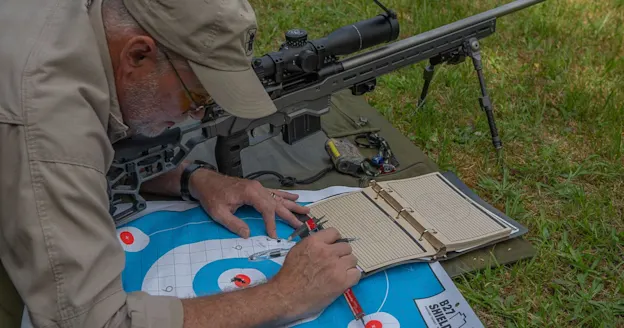_We may earn revenue from the products available on this page and participate in affiliate programs. Learn more ›
_
The Long Game is a new series designed to improve your long-range-shooting skills. This story is the second installment.
To get consistent hits on targets smaller than a refrigerator past 500 yards, you’ll need the help from ballistics calculators. The best way to look at ballistics calculators is to consider it a virtual and smarter version of your high school physics teacher. A capable ballistics program will allow for the entry of all the external ballistics data discussed in Part 1
, as well as particulars for the rifle and the optical sight you’re using. Ideally, the program/app will be something you can manage on your smart phone or a small tablet. The best ballistic calculators let you save data for different loads and conditions. Some are free, but the best ones will cost you a few bucks.
Ultimately, your ballistic calculator will provide you with shooting solutions in either minutes of angle, MILs, or inches, detailing the correct windage and elevation corrections you must make with your adjustment turrets or reticle. Ideally, you’ll want a program that provides solutions in all three. You may have a MOA-based riflescope now but if you replace it with a MIL-based scope in the future, you don’t want to start again from scratch.
MOAs and MILs
What’s the difference in a MOA and a MIL? Minute of Angle (MOA) is an angular measurement that equates to 1/60th of a degree or about one-inch (1.047-inches) at 100 yards. A mil (MIL) is an angular measurement dividing radians in a circle. There are 6,283 mils in a circle, and one mil equals 10 centimeters (3.6 inches) at 100 meters. It’s important to realize that both MOA and MIL are angular measurements that increase in size with distance. One MOA will equal 1.047 inches at 100 yards and twice that—2.094 inches—at 200 yards. Having the data provided in inches can also be handy when considering target size or observing impacts down range. The inch reference in your ballistic data is also convenient when your brain freezes, and you cannot convert MOA or MIL to actual, real-world measurements.
Ballistics Calculators with Wind Inputs
Avoid ballistic calculators that are products of a bullet or ammunition manufacturing companies. With few exceptions, most only offer only elementary solutions and do not allow for advanced data entry or calculation. The best ballistic calculators will interface with a weather/atmospheric collection device like a Kestrel. This allows for the automatic capture and calculation of wind speed and other external ballistic variables discussed in Part 1.
We will discuss wind meters more later on in this series, but they deserve mention here because wind is a critical element of your ballistic solution. And the effects of wind are best determined by a calculator that considers all the associated external ballistic factors. The less math shooters must do, the better they will shoot. For a good wind meter that’s linkable with a ballistics program you can pay as much as $700.
Feeding the Program Good Data
What we have not discussed is the requirement of ballistics calculators to have an accurate figure representing your rifle’s actual muzzle velocity. This applies to an accurate BC value as well. Good ballistics calculators will allow you to tune both, based on your real-world feedback. To get this data you’ll need a chronograph to measure your muzzle velocity, and ideally you will measure this at various temperatures. Without this bit of vital data your virtual physics professor is worthless.
In addition to the ballistics program, you will also obviously need a rangefinder. They can vary in price from affordable to ridiculous. (No one said that hitting at long range was easy or inexpensive.) After purchasing a reputable rifle, expect to pay that much or double for quality accessories. The primary thing to remember with a ballistics program is that they’re like any computer—if you put garbage in, garbage is what they will give you. You’ll also need a good long-range data book. This is where you’ll record all the information about your rifle, accessories, and ideally, record every shot you take.
By comparing what the ballistic program calculates your adjustments to be with the actual results on the target you can fine-tune your data for your muzzle velocity and BC value with whatever long-range cartridge you choose. Speaking of long-range cartridges, which are best? We’ll address that in Part 3.






